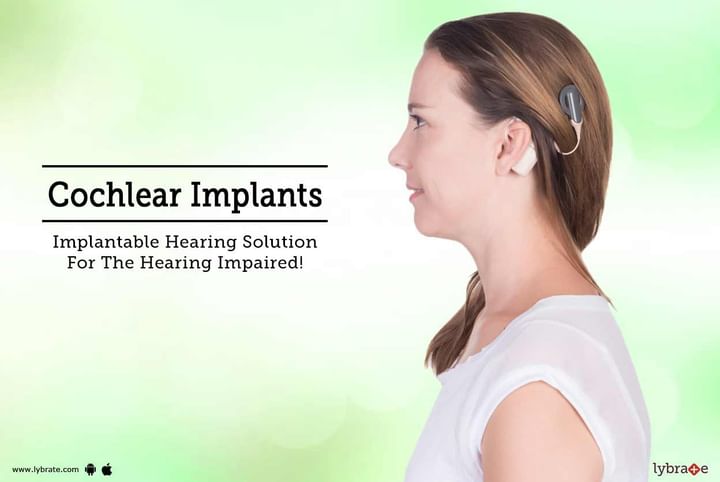Cochlear Implants - Implantable Hearing Solution For The Hearing Impaired!
A cochlear implant is a small electronic device that can help improve the hearing of people with severe, irreversible hearing loss. Although a cochlear implant does not restore normal hearing, it can allow a person to hear and understand more speech than was possible with a hearing aid. For a child, this could mean an opportunity to develop listening and speech skills and the potential to attend school with hearing peers. For adults, a cochlear implant could reduce social isolation and improve communication.
The Implant
The cochlear implant is a device that is placed in the inner ear. The implant system has three primary parts:
- Microphone and Transmitter —The headpiece and transmitter is worn above the ear to pick up sounds. These sounds are sent to a speech processor.
- Speech Processor — A speech processor is worn externally, behind the ear like a hearing aid, to convert sound into a digital code that is transmitted to an implanted stimulator.
- Implanted Stimulator — The implanted stimulator is a small component placed under the skin behind the ear. It receives a digital code from the speech processor and sends it to the auditory or hearing nerve.
The brain interprets this signal and it is recognized as sound. The small headpiece and transmitter is held in place by a magnet coupled the implanted stimulator, under the skin.
The Evaluation
Tests are done to determine if a child is a candidate for a cochlear implantation. Patients are selected based on medical and hearing histories and test results as well as findings. The evaluation, which differs slightly for children and adults, includes the following: *
- Medical Evaluation — Conducted by the cochlear implant surgeon who will take the medical history, examine your ears and explain the surgical process.
- CT Scan of the Temporal bone and MRI Brain and Cochlear imaging - This computerized tomography (CT) scan allows the surgeon to evaluate the ear's internal structure, recommend which ear to implant and may provide information as to the cause of deafness.
- Audiological Evaluation — This evaluation involves a hearing test to confirm the type and degree of hearing loss, hearing aid evaluation to assess the benefit provided by a hearing aid and aided speech recognition testing to determine if a hearing aid might provide greater benefit than an implant.
- Psychological Screening — This screening is conducted by psychologist to assess the feelings about hearing loss and the cochlear implant, such as the reasons for seeking the implant and the expectations.
- Cochlear Implant Counseling — At this time, if one is a candidate for cochlear implant, possible benefits and limitations will be explained and one will be provided with information to select the device.
To qualify for a cochlear implant, patients must meet the following criteria:
Adults age 18 and older have:
- Overall good health
- Severe hearing loss in both ears
- Limited benefit from conventional hearing aids determined by a trial period, when appropriate, of about three months
- Psychological and emotional stability
- Realistic expectations of the implant
- No ear conditions or other medical conditions that would interfere with surgery
- Ability to participate fully in a follow-up
Children age 1 to 17 must have:
- Overall good health
- Severe hearing loss in both ears
- Limited benefit from conventional hearing aids
- Realistic expectations of the cochlear implant
- No ear conditions or other medical conditions that would interfere with surgery
- Family commitment to comply with all evaluations before and after surgery
- Enrollment in a post-operative rehabilitative and educational program that supports the use of cochlear implants and the development of hearing skills
Device Programming
The externally worn speech processor is activated about four weeks after surgery. The processor converts speech into a special code for each user. The activation and programming is performed at the Hospital. Programming for each implant is customized for the patient and takes about six hours over a two-day period.
Testing
Visit at regular intervals for device checks and re-evaluation. During these visits, the implant and equipment are checked and performance is measured. Re-testing generally occurs at one, three and six months and one year following the initial device fitting. Then, semi-annual or annual evaluations are performed. Each session for adults involves about three hours.
Outcomes
Benefit from a cochlear implant usually improves with time but can't be guaranteed. Rehabilitation after surgery is key to maximizing the benefits of the cochlear implant. Most people with these implants are able to engage in hearing activities, such as listening to a Walkman, enjoying a movie, using a phone and participating in social activities. The motivation is critical to the success of the implant. Use the device during all waking hours, Listen, speak and interact with others as much as possible, Utilize visual cues when adjusting to the implant, but gradually decrease the use of visual cues when ready, Ask others to identify unfamiliar sounds so they become familiar.



+1.svg)
